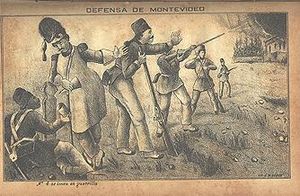
Justo José de Urquiza y García was an Argentine general and politician who served as president of the Argentine Confederation from 1854 to 1860.

The Argentine Confederation was the last predecessor state of modern Argentina; its name is still one of the official names of the country according to the Argentine Constitution, Article 35. It was the name of the country from 1831 to 1852, when the provinces were organized as a confederation without a head of state. The governor of Buenos Aires Province managed foreign relations during this time. Under his rule, the Argentine Confederation resisted attacks by Brazil, Bolivia, Uruguay, France and the United Kingdom, as well as other Argentine factions during the Argentine Civil Wars.

Manuel Ceferino Oribe y Viana was the 2nd Constitutional president of Uruguay and founder of Uruguay's National Party, the oldest Uruguayan political party and considered one of the two Uruguayan "traditional" parties, along with the Colorado Party, which was, until the 20th century, its only political adversary.
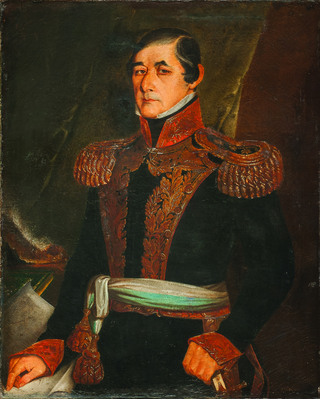
José Fructuoso Rivera y Toscana was a Uruguayan general and patriot who fought for the liberation of Banda Oriental from Brazilian rule, thrice served as President of Uruguay and was one of the instigators of the long Uruguayan Civil War. He is also considered to be the founder of the Colorado Party, which ruled Uruguay without interruption from 1865 until 1958. He made a controversial decision to almost completely eliminate the native Charrúa during the 1831 Massacre of Salsipuedes.

The Battle of Caseros was a military engagement fought near the town of El Palomar, Buenos Aires Province, Argentina, on 3 February 1852, between the Army of Buenos Aires commanded by Juan Manuel de Rosas and the Grand Army led by Justo José de Urquiza. The forces of Urquiza, caudillo and governor of Entre Ríos, defeated Rosas, who fled to the United Kingdom. This defeat marked a sharp division in the history of Argentina. As provisional Director of the Argentine Confederation, Urquiza sponsored the creation of the Constitution in 1853, and became the first constitutional President of Argentina in 1854.
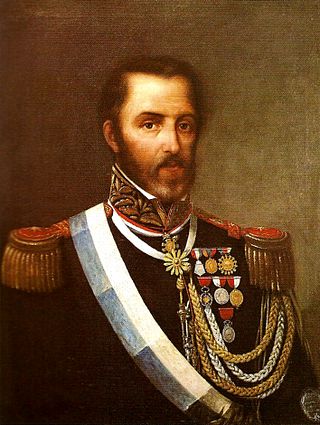
Juan Galo Lavalle was an Argentine military and political figure.

Brigadier General José María Paz y Haedo was an Argentine military figure, notable in the Argentine War of Independence and the Argentine Civil Wars.

The Uruguayan Civil War, also known in Spanish as the Guerra Grande, was a series of armed conflicts between the leaders of Uruguayan independence. While officially the war lasted from 1839 until 1851, it was a part of armed conflicts that started in 1832 and continued until the final military defeat of the Blancos faction in 1904.

Brazil–Uruguay relations encompass many complex relations over the span of three centuries, beginning in 1680 with the establishment of the Colónia do Sacramento, to the present day, between the Federative Republic of Brazil and the Oriental Republic of Uruguay. Brazil and Uruguay are neighbouring countries in South America, and share close political, economic and cultural ties. The singularity of the bilateral relationship between the two countries originates from a strong historical connection, as both countries having been territories of the Portuguese Empire and sharing the same language – marked by important events, such as the establishment of the Colónia do Sacramento in 1680, the invasion of the Banda Oriental by Brazil in 1815 and the subsequent creation of the Província Cisplatina, and Uruguay's independence from Brazil in 1828. The bilateral relationship was further defined by the Uruguayan Civil War (1839–1851) and the Paraguayan War (1864–1870).

Ricardo Ramón López Jordán (1822–1889) was an Argentine soldier and politician, one of the last influential "caudillos" in the history of Argentina. He thrice rebelled against the government of Buenos Aires and was defeated in each attempt.

The Platine War was fought between the Argentine Confederation and an alliance consisting of the Empire of Brazil, Uruguay, and the Argentine provinces of Entre Ríos and Corrientes, with the participation of the Republic of Paraguay as Brazil's co-belligerent and ally. The war was part of a decades-long dispute between Argentina and Brazil for influence over Uruguay and Paraguay, and hegemony over the Platine region. The conflict took place in Uruguay and northeastern Argentina, and on the Río de la Plata. Uruguay's internal troubles, including the longrunning Uruguayan Civil War, were heavily influential factors leading to the Platine War.
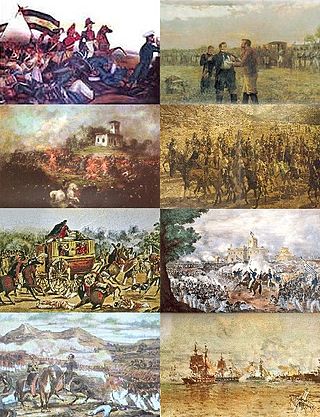
The Argentine Civil Wars were a series of civil conflicts of varying intensity that took place through the territories of Argentina from 1814 to 1853. Initiation concurrently with the Argentine War of Independence (1810–1820), the conflict prevented the formation of a stable governing body until the signing of the Argentine Constitution of 1853, followed by low frequency skirmishes that ended with the Federalization of Buenos Aires. The period saw heavy intervention from the Brazilian Empire that fought against state and provinces in multiple wars. Breakaway nations, former territories of the viceroyalty such as the Banda Oriental, Paraguay and the Alto Peru were involved to varying degrees. Foreign powers such as British and French empires put heavy pressure on the fledging nations at times of international war.

José Rivera Indarte was an Argentine poet and journalist. He was at times both a supporter and critic of Juan Manuel de Rosas, writing first the "Anthem of the Restorers" and later the "Blood tables".

Pascual Echagüe, was an Argentine soldier and politician. He served as Governor of Entre Ríos and Santa Fe provinces and Minister of War and Navy during the governments of Urquiza and Derqui. He participated in the Argentine Civil Wars and the Uruguayan Civil War.

Ángel Pacheco, was an Argentine military officer trained by José de San Martín who later became one of the top commanders in the Confederacy during the dictatorship of Juan Manuel de Rosas. He never lost a battle under his command.
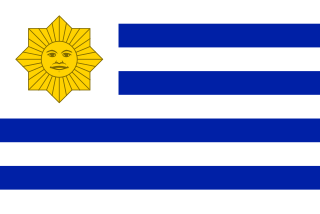
The Cerrito Government governed almost all the Uruguayan territory during the Great Siege of Montevideo (1843-1851). It was led by Manuel Oribe y Viana.
Ramón de Amaya was an Argentine-Uruguayan military man and politician, who fought against the English during the British invasions of the River Plate, and who participated in the Uruguayan Civil War.
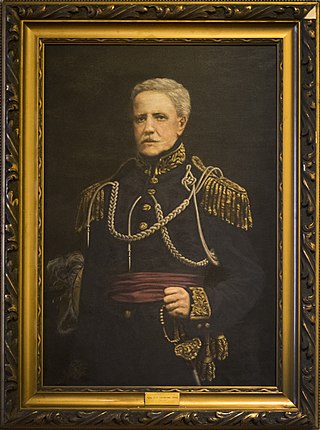
José Brito del Pino (1797–1877) was a Uruguayan soldier and patriot, who participated in the Argentine War of Independence, the Cisplatine War and the Uruguayan Civil War. He was one of the founding members of the Partido Nacional Uruguayo.

Batallón de Voluntarios Rebajados de Buenos Aires was a 19th-century Argentine military unit formed mainly with veterans of the Brazilian War and the expeditionaries to the Desert of 1833 and 1834. It was a special unit of the Federal Party of active participation during the civil war between federales and unitarios.
The Classical Monetary System of the Oriental Republic of Uruguay includes the coins minted by the Oriental Republic of Uruguay between the years 1840 and 1855 in the national territory. These coins were minted entirely within the city of Montevideo, first at the "Taller y Armería Jouve" owned by a French artisan named Agustín Jouve and later at the Casa de Moneda de Montevideo or Casa de Moneda Nacional, which was created for this purpose.
